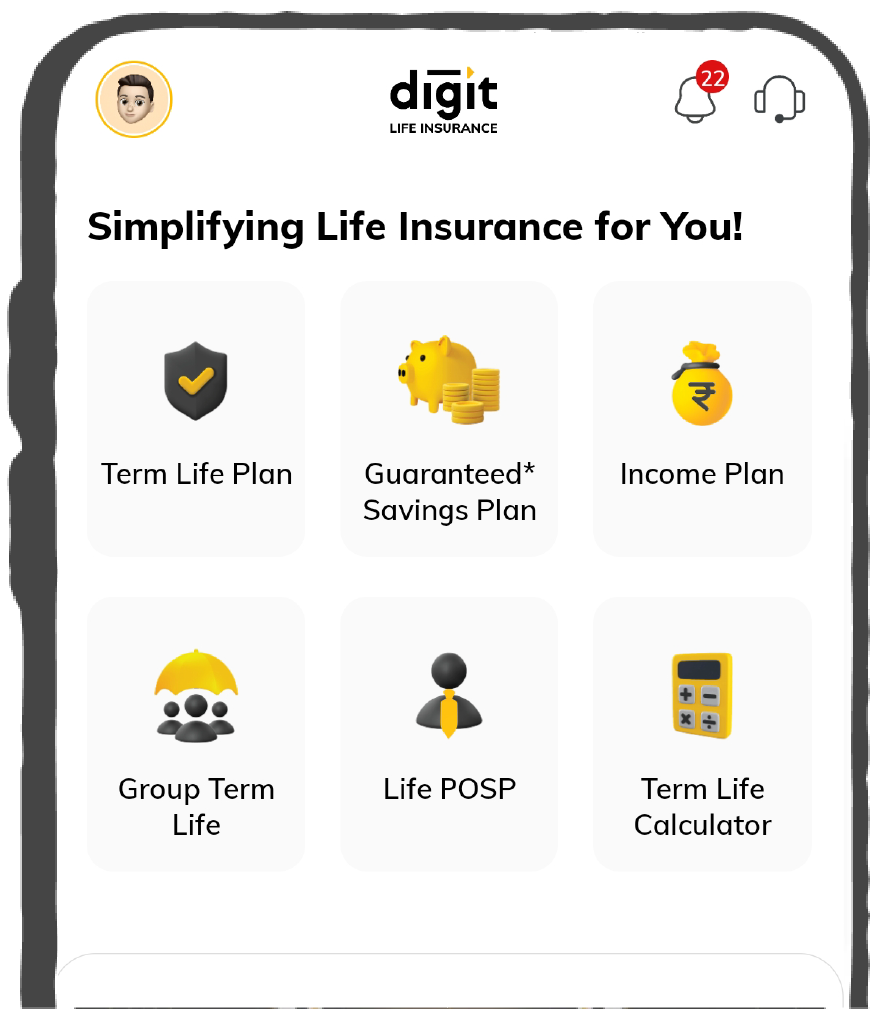What are the Differences Between Policy Term and Premium Paying Term?


Table of Contents

Differences Between Policy Term & Premium Paying Term
The policy term is the overall duration for which an insurance policy remains active. In contrast, the premium-paying term is the period in the policy during which the policyholder is obligated to pay premiums. Understanding both these terms is necessary for proper insurance plan management.
Here is the table demonstrating the difference between policy term and premium paying term:
With a clear understanding of the differences between policy and premium paying terms, you can now purchase your policies considering what suits you best. You can carefully choose the period until which you would like to pay your premium and the period until you would like to stay covered under your insurance policy.
What is the Policy Term?
The policy term is the duration you stay covered under an insurance plan. Nevertheless, you must pay the policy premiums on time to stay covered until the policy term or tenure ends.
Insurance providers let you choose a term on your own accord. For example, a health insurance policy generally comes with a tenure of 5, 10, or 20 years to 35 years. When the policy term ends, you cannot claim your policy benefit. You must purchase another policy to secure yourself after the policy tenure ends.
What is the Premium Paying Term?
The premium-paying term refers to the total period or years until you need to continue paying your premium. You must pay it until this term is over according to your chosen frequency.
The different premium payment terms are as follows:
- Single Premium Paying Term: You must pay a single premium in a lump sum to get coverage up to your policy term.
- Regular Premium Paying Term: You must pay a renewal premium after a regular interval to stay covered under your existing policy.
- Limited Premium Paying Term: You must pay periodic premiums up to a predetermined duration, much lower than the policy term. However, you will get coverage till the end of your policy term.
Now that you know the difference between policy and premium-paying terms, you can understand the two phenomena.
Considerations for Choosing Policy Term & Premium Paying Term
Long-term Financial Planning
Consider your risks, such as loans, children's education, or retirement. It is up to you when you want this protection to begin. A good fit between Policy Term and Premium Paying Term (PPT) ensures you are covered at the right time.Premium Paying Term and Coverage
Make a balance between the amount you can pay during the PPT and the one that would meet your coverage requirements. Conduct some research on your current finances and probable changes in your future. You should find a PPT where you can pay premiums without financial strain while you are still working.Changes in the Situation
Life can change, and so can your financial situation. You will want a Premium-Paying Term that is flexible enough to change with income, expenses, or a shift in priorities. Review the policy regularly to determine whether it fits at the moment and alter it if necessary to continue towards goal fulfilment.Policy Surrender Options
Know your policy surrender options. Flexibility may be useful when you change your financial situation or when more beneficial products are available. So, choose a term insurance policy with good surrender options so you can adjust according to changing financial needs.Influence on Policy Premiums
Examining how PPT affects premiums can reveal the net cost. The shorter the PPTs, the higher the annual premium will be, whereas longer PPTs are relatively cheaper. Compare premium rates for different PPTs and choose the one that best suits your pocket yet provides value for money.FAQs about Policy Term vs Premium Paying Term
Can I partially withdraw my funds before the policy term?
Will my policy term end if I do not repay a premium?
What is the minimum premium paying term?
What is a premium due date in a term insurance plan?
Can I modify my premium paying term once the policy has begun?
Can I shorten the policy term without compromising my insurance coverage?
What are the consequences if I pay my premium after the due date?
How does the premium paying term affect the sum assured in a policy?
Am I able to extend the duration of my premium paying term?
What is the key difference between the policy and premium paying terms?
Which is better to avail: a longer policy term or a shorter premium paying term?
Other Important Articles about Term Insurance Features
Other Important Articles Related to Term Insurance
Disclaimer
- This is an informative article provided on 'as is' basis for awareness purpose only and not intended as a professional advice. The content of the article is derived from various open sources across the Internet. Digit Life Insurance is not promoting or recommending any aspect in the article or its correctness. Please verify the information and your requirement before taking any decisions.
- All the figures reflected in the article are for illustrative purposes. The premium for Coverage that one buys depends on various factors including customer requirements, eligibility, age, demography, insurance provider, product, coverage amount, term and other factors
- Tax Benefits, if applicable depend on the Tax Regime opted by the individual and the applicable tax provision. Please consult your Tax consultant before making any decision.
Latest News
27-03-2025
Life Insurance: Is 10x Income Enough Coverage In 2025?
A survey by Bajaj Allianz Life Insurance and NielsenIQ reveals that 1 in 3 Indians have never reviewed their life insurance coverage, even after major life events. While 81% believe coverage less than 10 times their annual income is adequate, the actual average is just 3.1 times. This highlights a significant financial protection gap. Despite this, 82% of Indians are confident in their current policies. The survey underscores the need for better financial awareness and adequate life insurance coverage in India.
27-03-2025
Huge Insurance Deals! ₹38,000 Cr Changed Hands Quickly.
In the past two weeks, the insurance industry saw major deals worth over Rs 38,000 crore. The largest was Bajaj Group's Rs 24,180 crore acquisition of Allianz’s stake in their joint ventures. Patanjali acquired a stake in Magma General Insurance, and IndusInd International Holdings bought Reliance Capital, which owns Reliance Nippon Life and Reliance General Insurance. Additionally, the UK-based Prudential Group partnered with HCL Group to create a standalone health insurance company.
25-03-2025
₹62 Lakh Crore: Life Insurance Industry's Growth Explained
IRDAI data shows the life insurance industry's AUM grew over 9%, from Rs. 55 lakh crore in March 2023 to Rs. 62 lakh crore in March 2024. LIC India leads with Rs. 44 lakh crore, 72% of the total AUM. Private players hold Rs. 18 lakh crore. SBI Life and HDFC Life follow with Rs. 3.85 lakh crore and Rs. 2.87 lakh crore, respectively. Tata AIA Life saw the highest growth at 39%. New entrants include Go Digit Life, Credit Access Life, and Acko Life.
25-03-2025
₹62 Lakh Crore: Life Insurance Industry's Growth Explained
IRDAI data shows the life insurance industry's AUM grew over 9%, from Rs. 55 lakh crore in March 2023 to Rs. 62 lakh crore in March 2024. LIC India leads with Rs. 44 lakh crore, 72% of the total AUM. Private players hold Rs. 18 lakh crore. SBI Life and HDFC Life follow with Rs. 3.85 lakh crore and Rs. 2.87 lakh crore, respectively. Tata AIA Life saw the highest growth at 39%. New entrants include Go Digit Life, Credit Access Life, and Acko Life.
14-03-2025
Life Insurers See 5.7% Premium Growth: April-Feb Report
In February, life-insurance companies saw an 11.6% drop in new business premiums (NBP) due to a 22% decline in premiums from state-owned LIC. However, from April to February FY25, overall premiums grew by 5.71% to Rs 3.35 trillion. LIC's premiums increased by 1.90% to Rs 1.90 trillion, while private insurers saw an 11.11% growth, reaching Rs 1.46 trillion.
14-03-2025
Life Insurers See 5.7% Premium Growth: April-Feb Report
In February, life-insurance companies saw an 11.6% drop in new business premiums (NBP) due to a 22% decline in premiums from state-owned LIC. However, from April to February FY25, overall premiums grew by 5.71% to Rs 3.35 trillion. LIC's premiums increased by 1.90% to Rs 1.90 trillion, while private insurers saw an 11.11% growth, reaching Rs 1.46 trillion.
04-03-2025
Life Insurance Agents Surge: 3 Million in 2025
Volkswagen India will launch the Golf GTI and Tiguan R-Line by the end of Q2 2025. The Tiguan R-Line, unveiled in 2023, features aggressive styling, larger 19-inch alloy wheels, and LED light bars. Inside, it boasts a 12.9-inch touchscreen, 10.3-inch digital instrument console, and ambient lighting. Powered by a 2.0-litre turbo-petrol engine with 261bhp and 400Nm, it offers six-speed manual and seven-speed DCT automatic transmissions.
04-03-2025
Life Insurance Agents Surge: 3 Million in 2025
Volkswagen India will launch the Golf GTI and Tiguan R-Line by the end of Q2 2025. The Tiguan R-Line, unveiled in 2023, features aggressive styling, larger 19-inch alloy wheels, and LED light bars. Inside, it boasts a 12.9-inch touchscreen, 10.3-inch digital instrument console, and ambient lighting. Powered by a 2.0-litre turbo-petrol engine with 261bhp and 400Nm, it offers six-speed manual and seven-speed DCT automatic transmissions.
19-02-2025
Life Insurance: FDI Boosts Growth Potential | 2025 Update
The Indian life insurance sector is set to grow significantly with the government's decision to raise the Foreign Direct Investment (FDI) limit to 100%. This move will provide the necessary capital for industry expansion, allowing insurers to increase mortality coverage and market penetration. Private insurers have already seen a notable rise in retail sum assured, outpacing new business premiums. The shift to unit-linked investment plans (ULIPs) may pressure margins, but increased capital inflows will help meet the growing demand for coverage.
12-02-2025
Budget 2025 Brings Changes to ULIP Taxation
The Union Budget 2025 has redefined the taxation landscape for Unit Linked Insurance Policies (ULIPs). Starting April 1, 2026, ULIPs with annual premiums exceeding ₹2.5 lakh will be classified as capital assets, subjecting their gains to capital gains tax rather than treating them as income from other sources. This amendment aims to align ULIP taxation with other equity-oriented investments, ensuring a uniform tax treatment across financial products. Policyholders are advised to reassess their investment strategies in light of these changes to optimize their tax liabilities.
Read More






